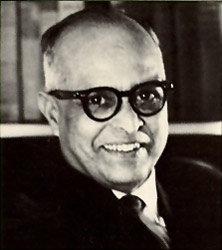The Bachelor of Arts is the saga of a young mind gradually moving towards maturity. The story illustrates the need of possessing a Bachelor of Arts degree and also portrays the dilemmas associated with it. Rightly named as the The Bachelor of Arts the impersonates the journey of the young boy, Chandran. R.K. Narayan`s Bachelor of Arts, with its detailed characterization and deftly knitted style therefore stands apart as journey from fantasy to reality.
Rasipuram Krishnaswami Ayyar Naranayanaswami, popularly known as R. K. Narayan was born in Madras in 1906. He studied at Maharajah`s College in Mysore. During his whole lifetime he has published numerous novels, five collections of short stories, two travel books, four collections of essays, a memoir, and some translations of Indian epics and myths. In 1980, the Royal Society of Literature awarded R.K.Narayan by A. C. Benson award. R. K. Narayan was also made Honorary Member of the American Academy and Institute of Arts and Letters. In 1989 he was made a member of the Rajya Sabha. In 1958 he received the Sahitya Akademi Award for one of his unforgettable creature `The guide`. Some of his works were also embellished with cartoons by his famous brother, R.K.Laxman.
 Synopsis: The Bachelor Of Arts, written by R.K. Narayan in 1937, is actually the second book of a trilogy that bagan with `Swami and friends` and ended with `The English Teacher`. The story is set in a make-believe south indian town called Malguri. The time is pre-independence and it captures the spirit of indians in sufferings of the freedom struggle and also the east-west clash. This is mainly based on the need of possessing a Bachelor of Arts degree and also the quandaries faced by a B.A. The protagonist here is a young boy named Chandran. The boy is from a upper midddle class youth of that time period and his progression from a collenge life to a sweet love life with a girl. Chandran`s clamber with cultural societeis of college, the teacher `Gajapathi` who teaches Shakespeare in accented English, struggles with time table, exams interpolated with secret cigerette smoking sessions and also watching films are described so colourfully that anyone can experience of being at that time. After graduation when he tries to marry that girl, he got rejected by her parents because of his horopcope. It says that he is mangalik and if he marries any non mangalik girl she will die eventually. So this frustrates him a lot and he left in search of some peace in his life which ends in making him a sage. During his adventure he meets many people and get enough respect by simple people. But after some days under some compunctions he returns home and joined a job as newsagent. To please his parents he finally got married and the most comical part lies in its ending when he falls in love afresh with his wife.
Synopsis: The Bachelor Of Arts, written by R.K. Narayan in 1937, is actually the second book of a trilogy that bagan with `Swami and friends` and ended with `The English Teacher`. The story is set in a make-believe south indian town called Malguri. The time is pre-independence and it captures the spirit of indians in sufferings of the freedom struggle and also the east-west clash. This is mainly based on the need of possessing a Bachelor of Arts degree and also the quandaries faced by a B.A. The protagonist here is a young boy named Chandran. The boy is from a upper midddle class youth of that time period and his progression from a collenge life to a sweet love life with a girl. Chandran`s clamber with cultural societeis of college, the teacher `Gajapathi` who teaches Shakespeare in accented English, struggles with time table, exams interpolated with secret cigerette smoking sessions and also watching films are described so colourfully that anyone can experience of being at that time. After graduation when he tries to marry that girl, he got rejected by her parents because of his horopcope. It says that he is mangalik and if he marries any non mangalik girl she will die eventually. So this frustrates him a lot and he left in search of some peace in his life which ends in making him a sage. During his adventure he meets many people and get enough respect by simple people. But after some days under some compunctions he returns home and joined a job as newsagent. To please his parents he finally got married and the most comical part lies in its ending when he falls in love afresh with his wife.
This book The Bachelor Of Arts by R.K. Narayan is published by University of Chicago Press in 1937 in USA edition while in UK edition the publisher is William Heinemann. Some other UK publishers are Vintage, Minerva, and Mandarin.
The bachelor of arts thus weaves the saga of a teenage mind to mellowness. The intelligent and beautiful strokes of reality further makes this story a tale of reality. The very concept of the gradual growing of a boy and then becoming busy with worldly affairs is nicely depicted with utmost tenderness.
.



















